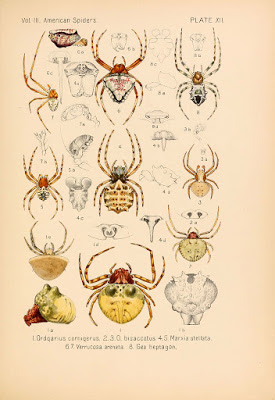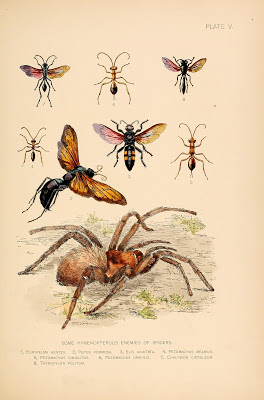BHL: Continuing to Inspire a Love of Natural History
In the Northern Hemisphere, the winter season is well underway. Cold temperatures mean that species of all kinds must face many new challenges in order to survive the next few months.
Spiders are no exception.
One might assume that spiders die off once winter hits. While this is true for some species, it is not true for all spiders – many remain active in winter months. How do they manage this? Through a variety of physiological and behavioral adaptations. Behavioral adaptations include moving their homes to “overwintering sites” such as the “subnivean zone,” an area between the snow and the ground, or concealed locations in leaf litter or under bark, where it’s warmer. Spiders also have a physiological adaptation that helps them brave the cold months. They are able to accumulate glycols in their blood (i.e., antifreeze), which allows their tissues to remain unfrozen at temperatures well below freezing. And spiders aren’t the only critters capable of this – many invertebrates also possess this ability.
So, through a combination of ingenious adaptations, spiders are able deal with the cold of winter. The process isn’t perfect, of course. Spiders are not freeze tolerant, and their tissues cannot survive the process of freezing. However, their adaptations still give them much better odds than they would have otherwise.
 |
| Dr. Christopher Buddle. Associate Professor, McGill University. |
Fascinating information like this can be found for a variety of arthropods on Arthropod Ecology. The site is a blog authored by Dr. Christopher Buddle, an Associate Professor at McGill University in Montreal, Canada. Chris has been in his field of study for twenty years, and his interests include, not surprisingly, arthropod ecology, arachnology, and natural history.
Chris discovered BHL some time ago, but recently enjoyed a “rediscovery” when he found us on social media. By following @BioDivLibrary on Twitter and browsing our albums on Flickr, Chris discovered the stunning visual resources that BHL has to offer, and through this exchange, developed a new love for our collections. In fact, Twitter and Flickr have become his favorite BHL features. He checks the Twitter feed daily and our Flickr collections every few weeks. His use of the website itself happens about once a month, particularly when he’s trying to locate a specific publication, which he often subsequently downloads as a PDF for future use.
 |
| McCook, Henry C. American spiders and their spinningwork. v. 3 (1893). http://biodiversitylibrary.org/page/4492973. |
For Chris, BHL’s true impact comes from its ability to spark interest in natural history. As he explained,
“I feel that BHL has helped reignite a love of natural history, both for me at a personal level, but also more broadly in biology. Our current science is built upon those before us, and it’s easy to forget this. We tend to focus on current whiz-bang publications, using new techniques and new analytical approaches. We are in an era of big data, and big science. I applaud many of these new approaches, but we must be reminded that without Wallace, Bates, the Peckhams, or McCook, we wouldn’t be where we are today. Their contributions are still relevant and help inform current science, and these contributions are stored on BHL and accessible because of BHL. That is significant and important and should not be taken for granted.
I don’t use BHL directly in my research all that much, but it has happened! As an example, I was working on a paper related to jumping spiders, and as part of that, was collecting ant-mimicking jumping spiders in a local forest. I wanted to learn more about the species, and try to uncover what we know about its life history. An online search revealed a few recent papers on the species, but the really good stuff was written in the late 1800s by the Peckhams. George and Elizabeth Peckham were teachers in Wisconsin, back in the 1800s, and in their spare time watched and wrote about insects and spiders. Their work was quite meticulous. Thankfully, BHL had their paper, and I was able to download the PDF and learn a great deal about the species courtship. Having access to the old literature made this possible.
 |
| Peckham, George and Elizabeth. Ant-like spiders of the family Attidae. Occasional papers of the Natural History Society of Wisconsin. v. 2 (1892). http://biodiversitylibrary.org/page/31440598. |
Browsing through BHL, and the images from BHL on the Flickr page (which is probably where I spend the most time!), is truly inspiring. The old sketches, drawings, and paintings are masterpieces. Many of them tell a story: for example, I recall seeing some drawings of “Spiders and their enemies” – these images are more than a depiction of a species. These images tell about ecological interactions.
 |
| McCook, Henry C. American spiders and their spinningwork. v. 2 (1890). http://biodiversitylibrary.org/page/4489749. |
Natural history is seeing a revival, and papers such as Tschinkel & Wilson remind us about how our world makes more sense when we uncover the natural history of species, whether it’s a Pseudoscorpion, woodpecker or epiphyte. Igniting a passion for natural history sometimes takes a catalyst: perhaps a field trip, story, a line from an old paper, or an image. To me, this is among the most valuable contribution that BHL makes to our world. It’s not necessarily a ‘tangible’ outcome; it can’t be easily measured in clicks, research dollars, publications or citations. But the long term benefits may be enormous, whether it’s a researcher like me being reminded about the value of old literature, or whether it’s a high school student being inspired by the BHL Flickr set about orchids. We need passion and engagement about biodiversity across all sectors of society, and BHL certainly facilitates this.”
“Inspiring discovery through free access to biodiversity knowledge.” That’s BHL’s vision statement. Through not only open access to natural history literature, but also through other engagement outlets like Twitter and Facebook, through new presentations of our content, such as Flickr or online exhibitions, and through citizen science initiatives, we’re working hard to realize that vision and are thrilled to see the fruits of our labors through Chris’ testimony.
So, if you’re bundled up for the winter months, take a moment to think about the intrepid spiders in your local ecosystems that are putting millions of years of evolution to good use to brave the cold right along with you. And if we’ve sparked your interest in these amazing animals, do a search in our collection or browse our Flickr images to help fan the flames of discovery. It’s a blaze that just might help keep you warm this winter.





Leave a Comment